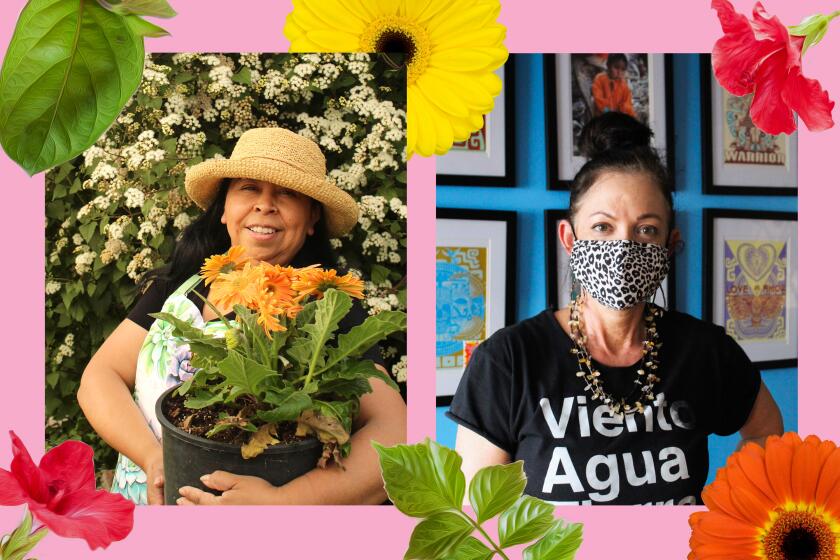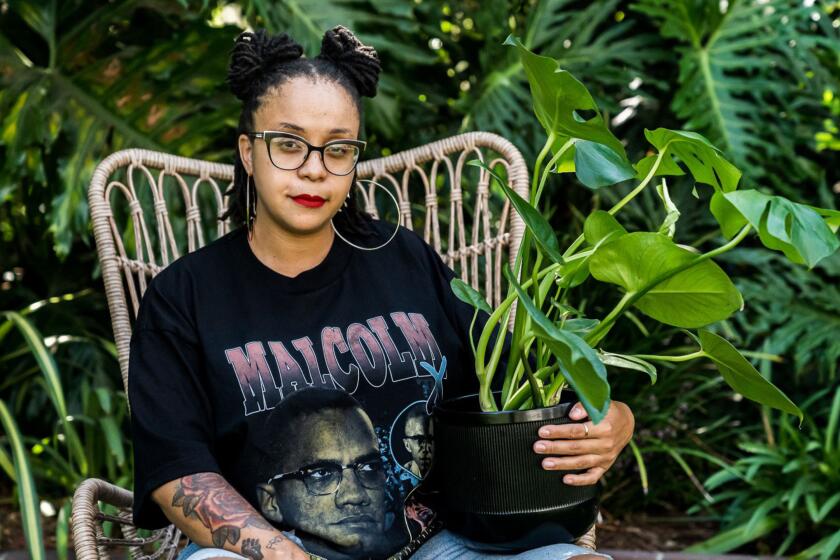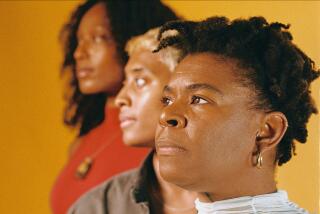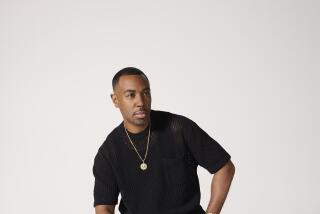This L.A.-based artist founded an Instagram community that uplifts Black men in the plant world
This is the latest in a series we call Plant PPL, where we interview people of color in the plant world. If you have any suggestions for PPL to include in our series, tag us on Instagram @latimesplants.
At 31 years old, Nelson ZêPequéno has already found his life’s purpose.
“It’s to solve creative problems in only a way that I can uniquely,” said the downtown L.A.-based artist, production designer and founder of the viral Instagram page @blackmenwithgardens.
ZêPequéno has answered this calling in many ways. On his website, plantsandanime.com — named for two of his greatest interests — he sells colorful T-shirts, the front pockets intricately embroidered with detailed flowers, cactuses and mushrooms. His online shop also features thrifted items like glass-faced analog clocks and old coffee mugs that he upcycles into unique planters.
ZêPequéno is also the founder of @blackmenwithgardens, an Instagram account with more than 134,000 followers that features photos and deeply personal stories of Black men and boys who garden, care for and enjoy plants. For ZêPequéno, even running the account fulfills his creative purpose.
In our Plant PPL series, we interview people of color in the plant world, including plantfluencers, plant stylists, floral artists, enthusiasts, experts and garden store owners.
ZêPequéno knew he was an artist from a young age. He was born in Ghana and immigrated with his family to the United States around the age of 5 or 6. As his family settled into their new home in New Jersey, ZêPequéno’s competitive nature drew the young immigrant toward art.
“My big sister when I was younger, she’d just like draw better than me,” ZêPequéno recalled. “And I just wanted to be able to draw better than her. So I decided to get better.”
But as he grew older, ZêPequéno realized that his desire to refine his artistic talents stemmed from something within himself.
“I had this overall vision that I could live my life based off of things that I created with my mind and hands,” he said.
This realization inspired him to pursue the creation of art across a wide array of multimedia forms.
ZêPequéno’s introduction to plant care came more than a decade ago when he was intrigued by the taboo surrounding cannabis.
“I started growing weed and learning cannabis horticulture indoors and outdoors,” he explained. “That just gave me an overall appreciation of admiring plants because growing cannabis requires you to really observe them on an almost microscopic level.”
But it was ZêPequéno’s lifelong passion for art that four years ago ultimately jumpstarted the diverse and expansive collection of plants that serve as a lush, green backdrop for the sunlit selfies and informational plant care videos he shares on his personal Instagram account, @zznelsonzz.
This interview has been edited for length and clarity.
What first sparked your interest in plants?
Multiple things drew me toward plants, one of them being art and painting — trying to draw plants. I decided to do a plant study one day and got some succulents. I didn’t have anything in my apartment at the time, and I just remember trying to draw them and using them as a reference, but then really enjoying them being in my apartment with me, because I wasn’t alone.
Living alone, having those plants on the windowsill just kind of made me happy. So I decided to get more and more, and the more I got, the more I was inspired by them. I was creating works of art, and just on a whim one day, I decided to incorporate some plants into a piece I was doing.
Then I started to put succulents in clocks and then old rotary telephones and anything I could find. I started to thrift a bunch of items that were at the end of their usefulness and infused them with these brand-new plants — most of the time baby succulents — which would start a whole new life cycle. It’s been really dope to watch that art form and a lot of those pieces grow.
I saw that you are the founder of the Instagram account @blackmenwithgardens. Can you tell me about that account?
Yeah, @blackmenwithgardens is an online community of black men … with gardens, as interesting as this sounds. During the time when me and Jasmine — the founder of @blackgirlswithgardens — created this space, there was a lack of the types of images you can find on my Instagram page. We were constantly being bombarded with imagery of Black and brown people being brutalized or victimized or [shown] in a disparaging light. We weren’t being depicted properly in the media.
It was also during that time that a lot of people started to get interested in things like gardening at home and farming. But it was hard to find visual references of one of us, so we created a space where we could share us with us, and have been growing it ever since then.
When did you found the account? What was the initial response like?
We started in 2018, and for the first couple of months, we were posting for 100 people … maybe 10 people were looking at our stories. Essentially we were just finding images of people that inspired us and sharing that with the people that inspired us.
We would resonate with each other, but there wasn’t this overall larger audience that wanted to see it or that knew exactly where to find it. So we kept refining. We didn’t let it discourage us that there were so many other large platforms that had the spotlight but weren’t showing Black and brown people. We just kept going in spite of that, and it just continuously grew from there.
Through a collaboration with Las Fotos Project, a Boyle Heights nonprofit, we partnered with nine high school students to work on mini Plant PPL profiles.
That’s a lot of followers! Why do you think your content resonates with so many people?
I think it has a lot to do with the media in general. I work in production — that’s why I live in Los Angeles — and I’ve been learning a lot about the industry. The media constructs a large overall perspective of how we see almost everything. So we have to realize how powerful these narratives are.
During the evolution of media across multiple formats, certain segments of people have held really strong control over it. And by doing that, they control the narrative of how everybody else looks. There’s only certain types of Black men that you see in media portrayals. You see the rapper, you see the athlete. One of those things that was missing is the Black guy that stays at home on the weekend and gardens and takes care of his family.
This is the real, average Black man, but the only portrayals we [see] are the exceptions or the ones that are being brutalized. Like I said, that creates a narrative. Our pages have continued to grow and be a light and beacon in spite of all that and show that, yo, we are so much more.
And these plants, that’s the best way for us to get these bigger stories out. It was the catalyst to get into some deeper dirt, mind my pun.
Would you say the Black community faces any unique barriers when it comes to getting involved in the plant world?
There’s all these barriers systemically and institutionally that we are being subjected to. It’s harder to really break through as a Black creator. When I first started making plant content, the algorithms on various social media platforms would group my content with either police brutality videos or Black wealth videos.
They were just grouping me in with something that they can associate with Black, whereas my counterparts that aren’t Black making plant videos were more likely to be pushed directly into the plant category by the algorithms.
As a Black creator, you get in and you think “I’m going to create the best stuff,” but there are these things that kind of make it more difficult. But, man, that just keeps making us stronger. They keep putting up barriers but, you know, we’re some of the best hurdle runners in the world. We just keep hopping over them.
I want to encourage as many Black, brown, minority, BIPOC creators to create from their own unique perspectives and innovate in every single industry, subject and topic that there is, because our stories need to be told from our perspectives, and our faces need to be shown — not just the palatable ones.
Courtney Warwick amplifies people of color and fashion in the plant community. You may know her from her ‘I Rap to My Plants’ merch or photo series ‘Sneakers and Plants.’
How has @blackmenwithgardens positively affected your community?
First and foremost, visibility. With visibility, opportunities become available. Five years ago, the majority of sponsorship dollars were going to a minority of content creators who all essentially looked the same, followed the same template and were part of the same groups. But we’re increasing the visibility of multiple characters and different variants of characters.
By increasing visibility across the spectrum, there’s more than just one type of Black person, one type of Latinx person, one type of Asian person that we are shown in the media. When we increase the visibility of the different types, more opportunities come to the different types.
Our platform has become a great platform to increase visibility for people that are within our specific industry, the plant industry, and helps them to be seen and to reach an audience of people that want to see them and support them.
Would you say that the work you do has affected the way people outside of your community view your community?
I know it impacts the way people see us. I’m 31 years old, so I kind of remember the early ’90s, and things were still kind of segregated. The way people talked was still f— up, the way people abused each other was still f— up. A lot of things that were allowable back then were on their way out by the early 2000s.
And now we have a solid 20 years of, let’s say, being progressive, and we’re all moving toward a better, more sensitive culture that takes into account these different things, but, I mean, it wasn’t that long ago that things were really bad.
We sit in a state now where we can be like, “Oh, well, things are fine, the Ku Klux Klan isn’t banging on my door right now.” But there’s still all these different issues that we deal with. It helps now that we all have the ability to connect, but that’s all still relatively new.
I’ve had old white ladies write me on Instagram and be like “Hey, because of your Instagram page, I’m more likely to think the Black guy walking behind me is on his way to a plant shop and not thinking about robbing me.”
That’s a real message that I got, and I think that was sent with sincerity. These are very real things, very real issues that we deal with, and the dope, almost simple act of just showing regular humans can counteract years of negative imageries.
Like I said, I stopped and realized when I started doing this that every single video was of a dead Black person on Instagram. People wanted to spread awareness, and the algorithms fed on that. I couldn’t even get on social media without seeing a dead Black person or minority being victimized in some type of way.
So every single post that I put up and created was a way of counteracting that by showing who we are as people, showing the specific topic that we’re interested in.
If you look deeper into any of the people that we’ve posted, they’re not just plant people. I’m not just a plant person. They are actual people with very complex, deep lives, and our page helps to show that to people. There are people that haven’t grown up with and never were close to Black people. When they see an Instagram page that allows them to have deeper insight, that’s beneficial.
Finally, as we ask everyone in this series, what is your favorite plant?
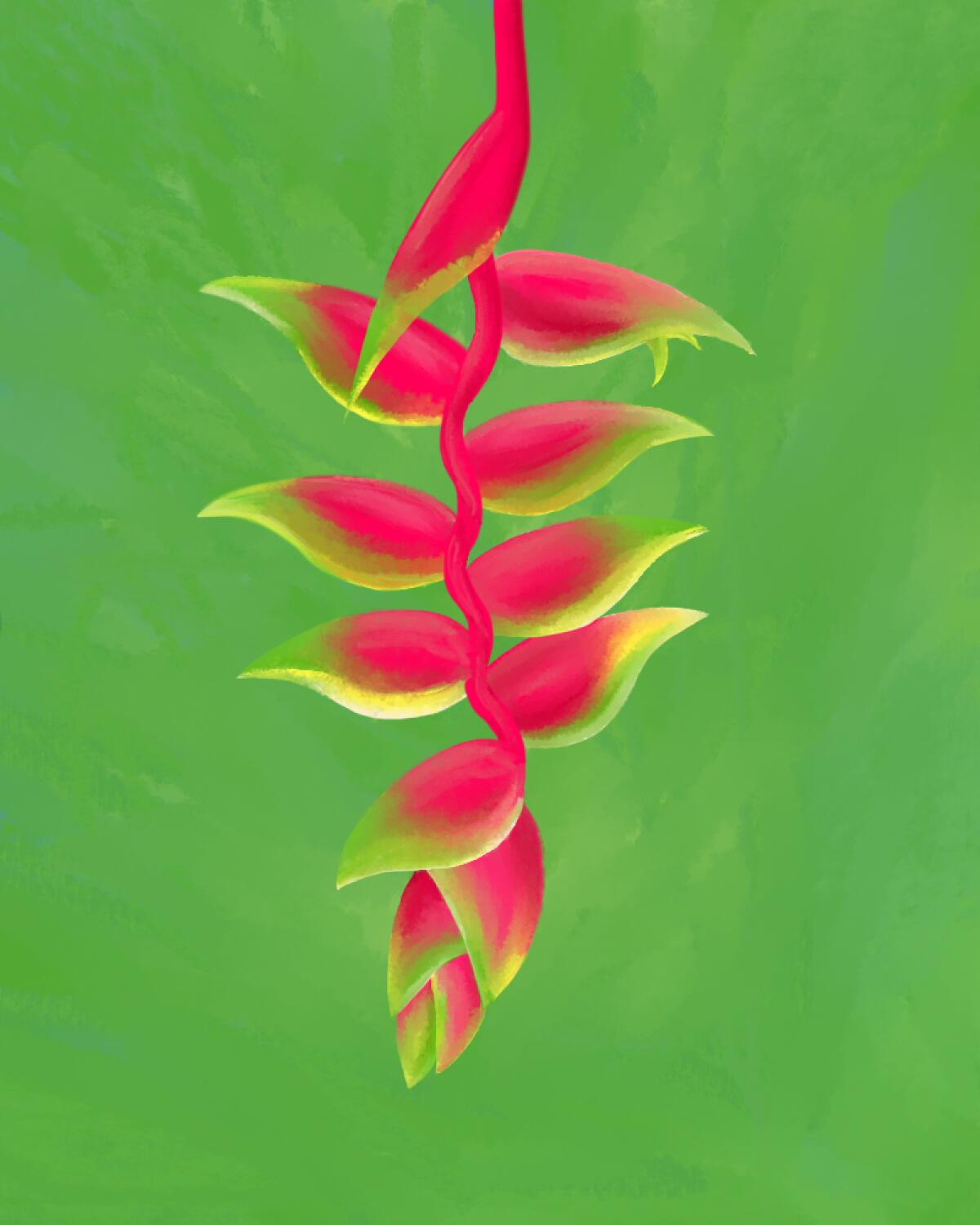
I don’t know if I have a favorite plant, actually. I never quantified them like that, but I will say that the heliconia is probably the plant that I’m most attracted to. When I see a heliconia flower out in nature anywhere, I’m always just like “Oh!” I would like to have one at my place, but it’s not necessarily realistic. It’s more of a tropical plant.
More to Read
Sign up for The Wild
We’ll help you find the best places to hike, bike and run, as well as the perfect silent spots for meditation and yoga.
You may occasionally receive promotional content from the Los Angeles Times.

